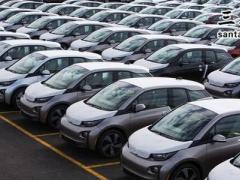印媒:超越中国,是印度中产阶级的幻想?
Overtaking China – Indian middle class fantasy ?超越中国-印度中产阶级的幻想?Middle class or opinion formin
Overtaking China – Indian middle class fantasy ?
超越中国-印度中产阶级的幻想?
Middle class or opinion forming class of our country have been afflicted with a particular malady over the last decade. The disease has got to do with competing with our giant neighbour across the Himalayas, in various international comparison lists in different spheres like economics, social indicators etc with GDP numbers being the clear favourite. However, does it serve any utility or is it just an exercise in chest thumping? For a long time, Pakistan was the main enemy or competitor in these lists by Indian public especially in Northern and Western India. But since 1980s India has marched ahead in almost all aspects and the name Pakistan has become synonymous with only negative aspects like terrorism. China is a different ball game altogether with the defeat of 1962 still a painful memory in the Indian psyche.
在过去的十年中,印度的中产阶级受到一种特殊疾病的折磨。这种疾病与我们和喜马拉雅山脉另一侧的庞大邻国的竞争有关,在不同领域的各种比较,如经济、社会指标等,GDP数据显然是最热门的比较。然而,这到底有什么用呢,只是过嘴瘾?长期以来,巴基斯坦一直是印度民众用来对比的主要敌人或竞争对手,特别是在印度北部和西部。但自上世纪80年代以来,印度几乎在所有方面都取得了进步,巴基斯坦这个名字成为了恐怖主义的代名词。而中国则完全不同,1962年那场战争的失败在印度人的心中仍是一段痛苦的记忆。
Both the countries share a number of similarities like huge population, vast land area, long history, spiritual past etc. Differences too galore. Chinese have adopted a socialist model of the economy with strong capitalist layer which seems to be getting deeper whereas India followed a mixed economy with capitalism gaining prominence only after 1990’s liberalisation. But the major difference is the one which is less highlighted but more emphatic at least according to me. This would be in ethnicity and resultant cultural differences spilling over to religion and language. India has been a melting pot of races through different waves of human migration after the early man left Africa around 2 lakh years back mainly via Khyber Pass in North West and to a lesser extent from east. The Chinese also have a similar historical trajectory with different waves of human migrations. However crucial difference arises when we examine the resultant impact of these migrations. India has welcomed all those who came in India with their language, customs and religion right up to Mughals save for British who never made India their homeland.
两国有许多相似之处,比如人口众多、国土辽阔、历史悠久等等。然而分歧也很大。中国选择了一种资本主义层次较强的社会主义经济模式,这种模式似乎在不断深化,而印度则选择了混合经济模式,上世纪90年代资本主义才开始崭露头角。但在我看来,最主要的区别是种族及由此产生的文化差异,并蔓延到宗教和语言。早在大约20万年前,早期人类离开非洲,主要通过西北部的开伯尔山口离开非洲。此后,印度经历了不同的人类迁徙浪潮,成为多个种族的大熔炉。中国人也有类似的历史轨迹,不同的人类迁徙浪潮。然而,当我们研究这些迁移的结果影响时,就会发现关键的差异。印度欢迎所有人带着他们的语言、习俗和宗教来到印度,不欢迎那些从未把印度作为自己家园的英国人。
This process of assimilation has made India a unique nation with language, religion, culture, dialects changing every 50 km. No empire had been able to unite present Indian nation with the largest empires being in ancient period of Maurya and Gupta period.
这一同化过程使印度成为一个独特的国家,每隔50公里就有不同的语言、宗教、文化和方言。没有一个古代帝国能够统一现在的印第安民族,包括孔雀王朝和笈多王朝。
The Middle Kingdom history is remarkably different with vast empires uniting and thriving as a single state with Han identity being forged across the landscape through these periods. Even though the Chinese language has both Mandarin and Cantonese dialects it’s the former which has gained prominence. Religion has singularly been absent or dormant among its population for the past 70 years, unlike India where it occupies the most important place in the identity of an individual.
中国的历史是截然不同的,各个幅员辽阔的帝国联合起来,作为一个单一的国家蓬勃发展。在这些时期,汉人的身份在各地形成。虽然汉语有普通话和粤语两种方言,但普通话占主导地位。奇怪的是,过去70年来,宗教在其人口中一直处于缺席或休眠状态,然而在印度,宗教在个人身份认同中占据着最重要的地位。
China has leapt ahead with its double-digit economic growth over the period of past 40-50 years beginning with 1979 reforms. The economy has grown multiple times becoming a factory of the world, living standards have improved, literacy rate over 90 per cent, health care indices approaching Western standards. World Trade has come to be dominated by China with some estimates accounting it at a quarter of global commerce. Military might have also grown with it becoming a nuclear power in the 1960s, acquiring ICBM technology and now aiming for bases all across the planet and even space both physical and cyber. It has also become a sports superpower with its athletes leading Olympic medal tally and successful completion of Beijing Olympics in 2008. Think tanks and drawing rooms of the world is abuzz with talks of rising of a superpower.
自1979年改革开放以来,中国在过去40-50年里实现了两位数的经济增长。中国经济增长了好几倍,成为世界工厂,生活水平有所提高,识字率超过90%,医保指数接近西方标准。世界贸易已由中国主导,一些人估计,中国占全球贸易的四分之一。上世纪60年代,随着中国成为核大国,获得洲际弹道导弹技术,并将目标瞄准全球乃至太空,中国的军事实力也可能随之增长。中国已成为体育超级大国,运动员在奥运会奖牌榜上名列前茅,并成功举办了2008年北京奥运会。世界各地的智库都在热烈讨论一个超级大国的崛起。
India the sleeping giant and elephant which is only just awakening from its slumber. Border disputes between the neighbours have made the Indian public demand aggressive response to Chinese aggression but the government seems hesitant to play the tough game. Reasons are not hard to understand, our economy is nowhere near China, militarily we are still focussed on settling scores with Pakistan and eastern front just not in the picture. Our army is bloated with poor supply and logistics support. From the reports coming in our air force is operating below its sanctioned squadron strength. Navy has just one aircraft carrier and that too of Soviet era. Majority of its planes are of the 1980s an older vintage.
印度,这头沉睡的大象,刚刚从睡梦中醒来。邻国之间的边界争端使印度公众要求对中国的侵略做出积极回应,但印度似乎不愿采取强硬手段。原因不难理解,我们的经济比中国落后很多,军事上我们仍然专注于解决与巴基斯坦的争端,东线尚未纳入考虑范围之内。我们的军队供应和后勤支援不足。从我们空军收到的报告来看,我们的空军力量不足。海军只有一艘航空母舰,还是苏联时代的。大多数战机都是上世纪80年代的老款。
We don’t have a list of companies to rival China like an Alibaba, Xiaomi or Huawei save for a Reliance and Tata. Most Indians like the rest of the world use Chinese manufactured electronic goods like phones and computers including the one is using to write this piece and most probably the one you are using to read it. Data privacy is an issue here. Another sad part is the lack of focus on research and the poor quality of Indian educational institutions in general. While China has a number of its institutions in top 200 universities of the world in science and arts. We are nowhere in the picture with only IIM and IITs that too few in number. Statistics comparing a number of research papers published by Indian academia paint a sad picture while Chinese are going from strength to strength. Chinese have taken efforts to study their history in a logical manner whereas Indian scene has off late been interested in mythmaking with stories of the airport in ancient Ayodhya and plastic surgery, nuclear weapons etc in epics.
除了信实和塔塔,我们没有一家像阿里巴巴、小米或华为这样可以与中国竞争的公司。大多数印度人和其他国家的人一样,使用中国制造的电子产品,比如手机和电脑,包括写这篇文章所用的这台电脑,你用来阅读这篇文章的手机有可能也是中国产的。在这方面,数据隐私是一个问题。另一个令人遗憾的地方是,印度对研究的重视不够,教育机构的整体质量也很差。而在世界顶尖的200所科学和艺术大学中,中国大学也有几所上榜。在这方面我们没有立足之地,而且印度管理学院和印度理工学院这样的名牌大学也太少。统计数据对比了印度学术界发表的一些研究论文,描绘了一幅可悲的画面,而中国的实力正在不断增强。中国人一直在努力用合乎逻辑的方式研究他们的历史,而印度人最近却对编造神话很感兴趣,比如古阿约提亚的机场,以及史诗中的整形手术、核武器等。
Aside from all these factors the point to be noted is regarding the requirement of competition in first place. India has far more pressing problems like the poor standard of living, illiteracy, child malnourishment etc. The solutions to these need to be found obviously and are more urgent than any imaginary throne for the ruling class to brag about. Wars are fought when resources are limited and there are competitors for the same piece of the pie. Most probably the trajectory of our growth points to the said scenario playing out eventually. But are we ready to face a tough competitor like China? Africa is supposed to be the next frontier in resource race . India with its historical links has failed to capitalize on the goodwill. Considering all these factors it would be futile for Indian middle class to daydream of competing with China. Every Indian home in 2019 has at least one Chinese product but the same cannot be said in reverse. India needs to get its act together by raising the living standards of its people, reducing its obsession with its western neighbour and only then develop any superpower ambition of its own.
除了所有这些因素外,首先要注意的是开展竞争的要求。印度有更紧迫的问题要解决,如生活水平低下、文盲、儿童营养不良等。显然需要先找到解决这些问题的办法,这比统治阶级吹嘘的任何想象中的王座都更为紧迫。当资源有限且有竞争对手争夺一块蛋糕时,就会发生战争。我们的增长轨迹可能表明,上述情况最终会发生。但是我们准备好面对像中国这样的强大竞争对手了吗?非洲被认为是资源竞争的下一个前沿。有着历史渊源的印度未能利用这种善意。考虑到所有这些因素,印度中产阶级幻想与中国竞争是徒劳的。2019年,每个印度家庭都至少有一种中国产品,但中国家庭就未必有印度产品。印度需要团结起来,提高人民的生活水平,减少对其西方邻国的迷恋,然后再发展自己的超级大国野心。(译自印度时报)
印度时报读者评论:
外文:https://timesofindia.indiatimes.com
Amohan-5 days ago -Follow
sir, we have taken off a lot since the past 30 years. economic progress in a large democracy takes time but it is bound to happen in the years to come.
在过去的30年里,我们取得了很大的进步。印度这么一个庞大的国家,经济发展需要时间,但注定会在未来几年发生。
sir, that's why i said " right political leadership etc. it is not day dreaming. once the chinese must have also had such dreams which they made come true. why can't we ? nothing is impossible.
有了正确的政治领导,这也不是白日梦。曾经,中国人一定也有过这样的梦想,他们使之成为现实。为什么我们不能?一切皆有可能。
5 days ago -Follow
there is nothing wrong in dreaming big to beat china as an economic superpower. with the right political leadership, policy making, ecosystem & with a huge talented youth power, knowledge & skills we can definitely do it & a day will certainly come when the chinese will be using our products in large numbers.
梦想着打败中国,成为经济超级大国,这也无可厚非。有了正确的政治领导、正确的政策、生态系统和年轻高技能人才,我们一定可以做到,总有一天,中国人会大量使用我们的产品。
AMohan - Unknown - 5 days ago -Follow
dear mr. mohan, glad to see yr. optimism - that is what baffles progressive thinkers when a survey showed that we are highly sure of our future, without plans/steps in place..?there is huge difference between 'dreaming' & day-dreaming..? unless our politics reforms upgrades cleanses itself.. that is next to impossible by themselves in stagnated pools of political narrow banners...can we catch up with china lagging behind by few decades.. of course in movies we enjoy hero on a bullock cart chasing villain on a deluxe-car..?
一项调查显示,我们对自己的未来充满信心,却没有计划和行动,进步的思想家对此感到困惑。做梦和做白日梦有很大的区别。这几乎是不可能的,除非我们的政治改革升级。我们比中国落后几十年,能赶上他们吗?当然,在电影中,我们喜欢看英雄骑着牛车追赶坐在豪华轿车的恶棍。
版权声明
我们致力于传递世界各地老百姓最真实、最直接、最详尽的对中国的看法
【版权与免责声明】如发现内容存在版权问题,烦请提供相关信息发邮件,
我们将及时沟通与处理。本站内容除非来源注明五毛网,否则均为网友转载,涉及言论、版权与本站无关。
本文仅代表作者观点,不代表本站立场。
本文来自网络,如有侵权及时联系本网站。
阅读:
-
1
चाइना में रेडी और ठेले Local shops in china || L...
- 2
- 3
- 4
- 5
- 6
- 7
- 8
- 9
- 10
-
1
चाइना में रेडी और ठेले Local shops in china || L...
- 2
- 3
- 4
- 5
- 6
- 7
- 8
- 9
- 10











